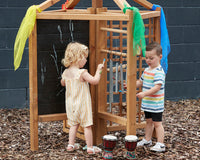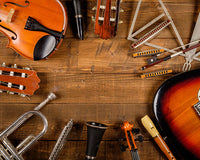Compensating Lower Brass
The term compensating is one that is often referred to but not always fully understood. It is normally used with reference to lower brass instruments (eg. Euphoniums & Tubas) which are either 'compensating' or 'non-compensating' models. There is a common misconception that if an instrument has a 4th valve* it is compensating, but that is not necessarily the case. I'll try to explain exactly what it means as clearly and concisely as possible, although that's easier said than done!
The Physics
To understand compensation you first need to grasp the underlying physics of brass instrument tone production. The sound is made by the player making a 'buzzing' effect with their lips, the vibrations produced are then passed through the instrument itself. The pitch of the note that an instrument produces in it's 'open' or 'natural' position (no valves depressed) is dependant on the overall length of tubing of that particular instrument. It is possible to play a range of notes with the instrument in its open position, in the way a Bugle or Post Horn does, but to produce all notes within a scale requires additional tubing and therefore, in the case of (most) brass instruments, valves. The natural pitch for the majority of brass instruments is Bb or Eb.
The Maths
We start to get a bit technical now and into the numbers so to keep things simpler I'm going to use Imperial rather than Metric and please note that all measurements quoted are approximate. To lower a note by an octave, the tube used to produce the sound needs to be doubled in length. The the tubing of a Bb Trumpet is 4 1/2 ft long, whereas the tubing of a Bb Trombone (sounding one octave lower) is 9 ft long. Therefore to change the pitch of a note the length of tubing has to be altered by a relative proportion, rather than an absolute length. On a BBb Tuba the length of it's tubing (open valves) is 18 ft. To lower its pitch by a semi tone you need to add an extra 1/12th to its length (18 ins). The 2nd valve slide will lower the pitch by a semi tone and will thus be 18 inches long. The 1st valve lowers the pitch by a whole tone (36 ins long) and the 3rd valve by 1 1/2 tones (54 ins long). A BBb tuba with its 1st and 3rd valves depressed will therefore actually be 25 1/2 feet in length. So to lower the pitch by an extra semi tone you need to add an extra 25 1/2 inches. However, the 2nd valve slide is only 18 inches long, leaving a shortfall of 7 1/2 inches in the tubing required to bring the note in tune. On a compensating instrument, this is achieved by the use of small sections of tubing (often referred to as 'knuckles') on the back of the valve block. Therefore, with a compensating system, the extra tubing is automatically engaged keeping the instrument in-tune with itself, however a non-compensating instrument would play slightly sharp (due to the lack of tubing). In smaller instruments such as Cornets and Trumpets compensation can be manually adjusted for using 1st and 3rd valve slides/triggers and some models now have triggers on the main tuning slide. However, the lengths involved in lower brass instruments means that compensating systems become a necessity for accurate tuning.
*A quick word on 4th valves...
In order to increase an instrument's range (downwards) a 4th valve is often added - taking the pitch down 2 1/2 tones when engaged. Obviously, the greater the length of tubing added to the instrument the better the range but the greater the need for compensation. It is possible to use the 4th valve in place of certain other valve combinations such as (1st+3rd) which will improve intonation. On traditional British instruments the 4th valve is usually positioned away from the main valve block on the side of the instrument, and played with the left hand.




















